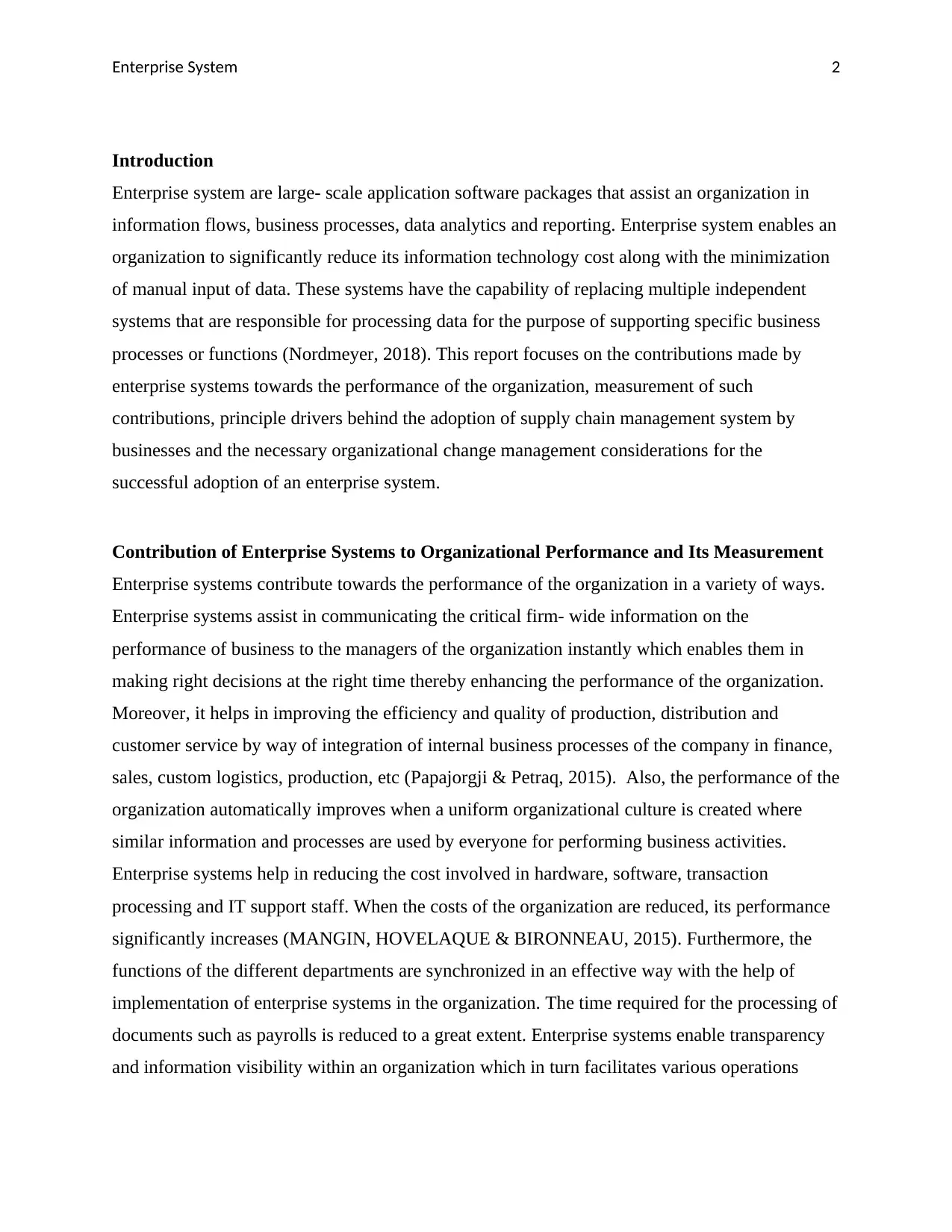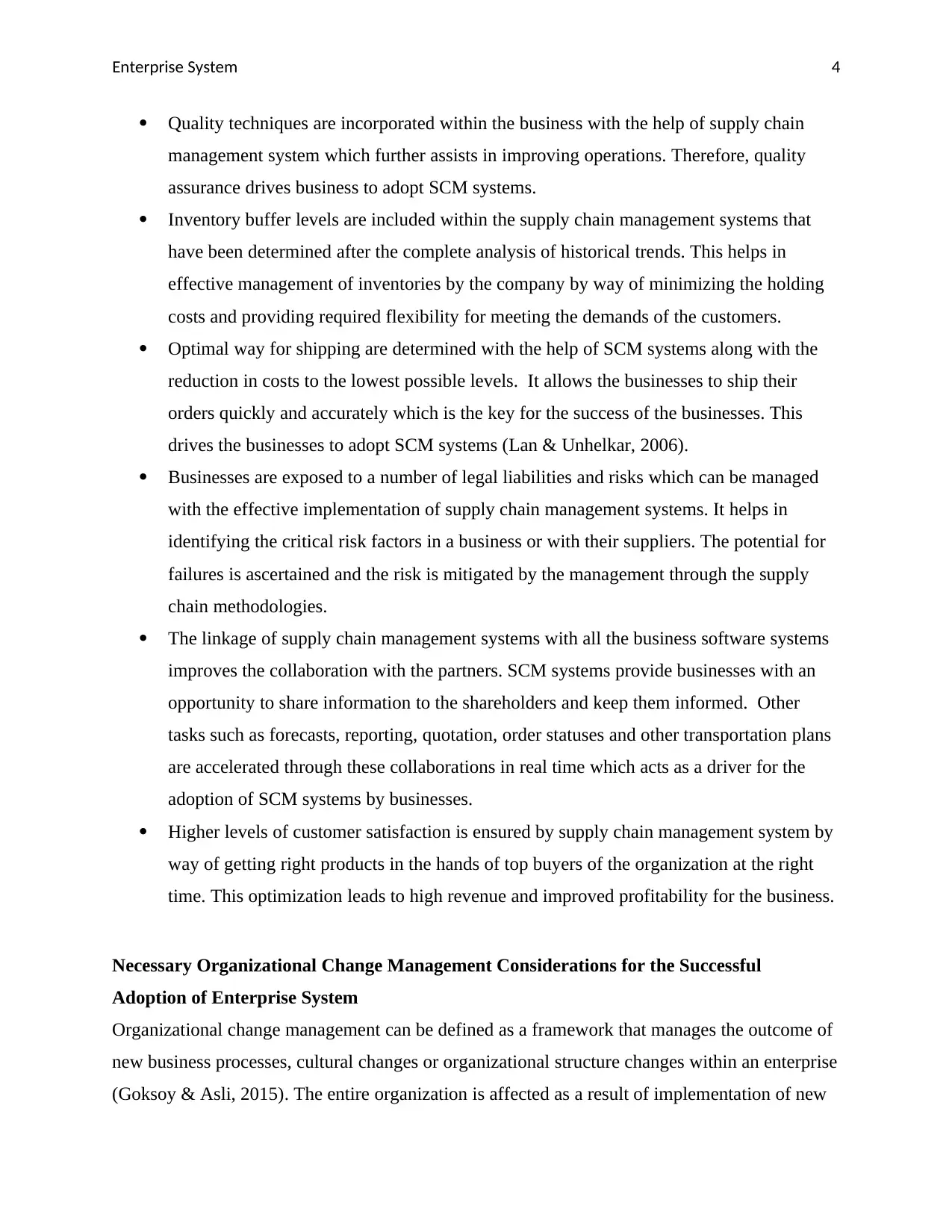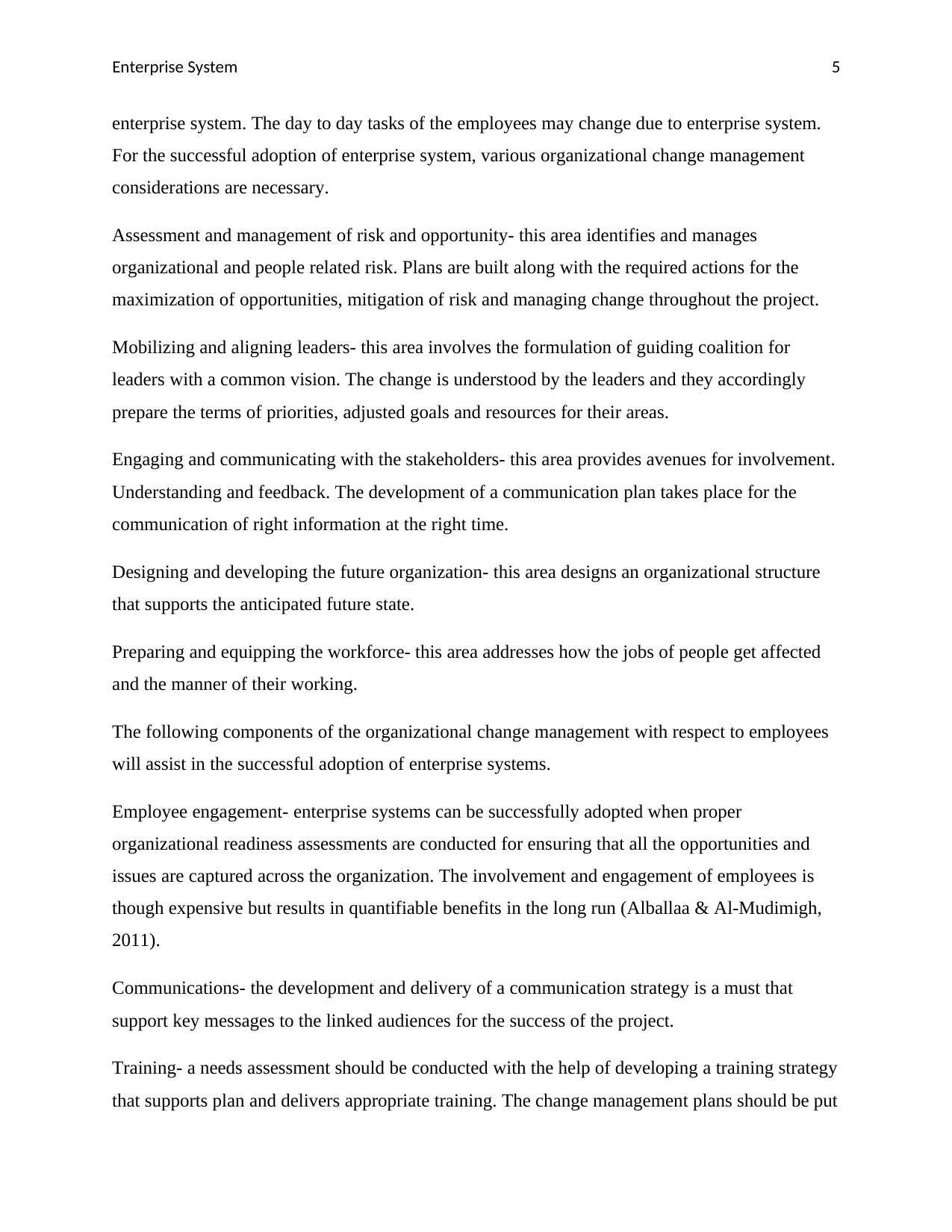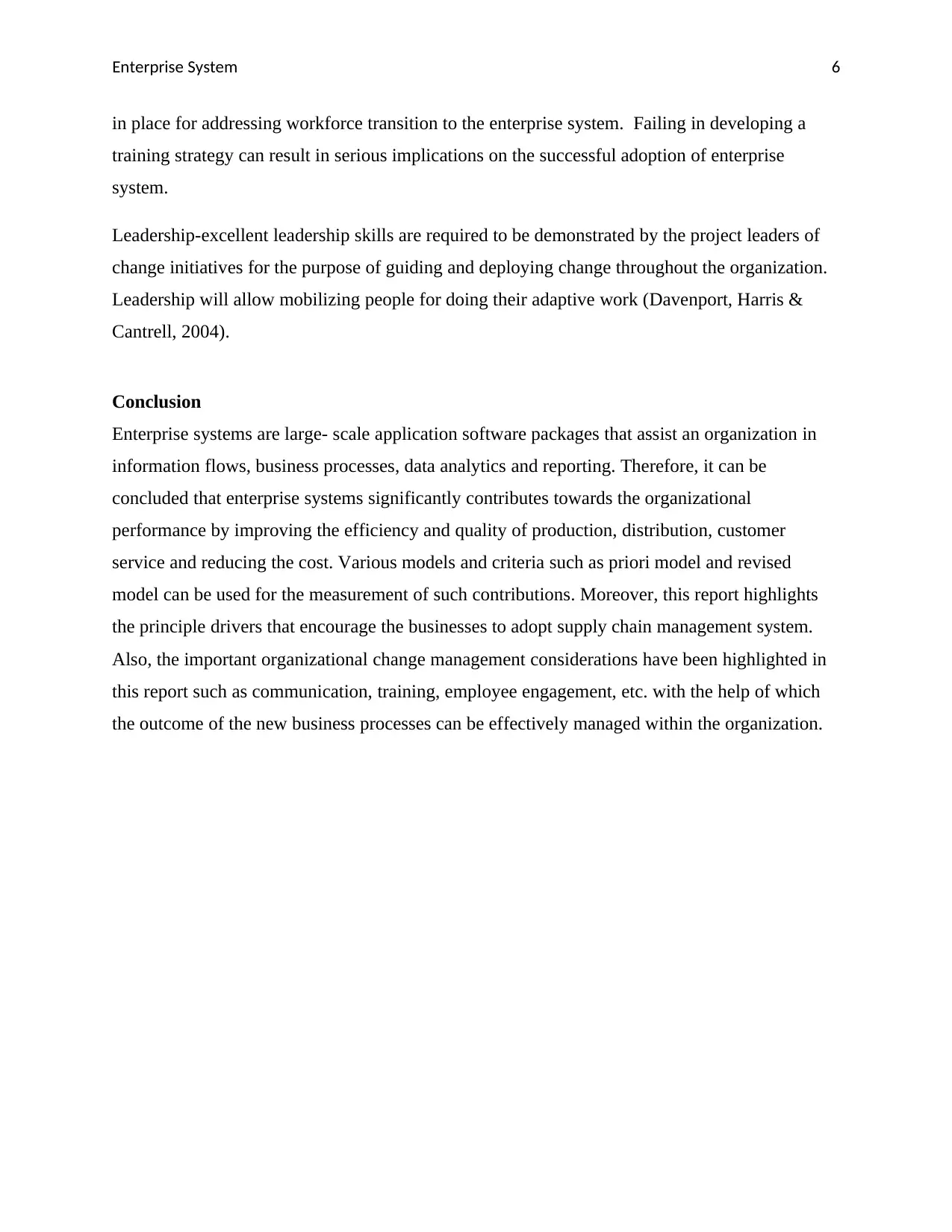ISY2005 Report: Evaluating Enterprise Systems & Organisational Change
VerifiedAdded on 2023/06/14
|9
|2195
|424
Report
AI Summary
This report examines the contributions of enterprise systems to organizational performance, focusing on how these systems improve efficiency, quality, and cost-effectiveness. It discusses various measurement models for assessing these contributions, such as the a priori and revised models, and highlights the drivers behind businesses adopting supply chain management (SCM) systems, including quality assurance, inventory management, and risk mitigation. Furthermore, the report addresses essential organizational change management considerations for successfully implementing enterprise systems, emphasizing employee engagement, communication, training, and leadership. The analysis concludes that enterprise systems significantly enhance organizational performance and that effective change management is crucial for their successful adoption. Desklib provides access to this report and many other solved assignments.

RUNNING HEAD: Enterprise System
Enterprise System
Enterprise System
Paraphrase This Document
Need a fresh take? Get an instant paraphrase of this document with our AI Paraphraser

Enterprise System 1
Executive Summary
Enterprise system are application software packages that helps an organization in data analytics,
information flows, business processes and reporting. This report focuses on various contributions that
enterprise systems make to the performance of an organization along with the manner with the help of
which such contributions can be measured. This report also provides the principle drivers behind the
increasing adoption of supply chain management systems by businesses and the necessary
organizational change management considerations for the successful adoption of enterprise system.
Executive Summary
Enterprise system are application software packages that helps an organization in data analytics,
information flows, business processes and reporting. This report focuses on various contributions that
enterprise systems make to the performance of an organization along with the manner with the help of
which such contributions can be measured. This report also provides the principle drivers behind the
increasing adoption of supply chain management systems by businesses and the necessary
organizational change management considerations for the successful adoption of enterprise system.

Enterprise System 2
Introduction
Enterprise system are large- scale application software packages that assist an organization in
information flows, business processes, data analytics and reporting. Enterprise system enables an
organization to significantly reduce its information technology cost along with the minimization
of manual input of data. These systems have the capability of replacing multiple independent
systems that are responsible for processing data for the purpose of supporting specific business
processes or functions (Nordmeyer, 2018). This report focuses on the contributions made by
enterprise systems towards the performance of the organization, measurement of such
contributions, principle drivers behind the adoption of supply chain management system by
businesses and the necessary organizational change management considerations for the
successful adoption of an enterprise system.
Contribution of Enterprise Systems to Organizational Performance and Its Measurement
Enterprise systems contribute towards the performance of the organization in a variety of ways.
Enterprise systems assist in communicating the critical firm- wide information on the
performance of business to the managers of the organization instantly which enables them in
making right decisions at the right time thereby enhancing the performance of the organization.
Moreover, it helps in improving the efficiency and quality of production, distribution and
customer service by way of integration of internal business processes of the company in finance,
sales, custom logistics, production, etc (Papajorgji & Petraq, 2015). Also, the performance of the
organization automatically improves when a uniform organizational culture is created where
similar information and processes are used by everyone for performing business activities.
Enterprise systems help in reducing the cost involved in hardware, software, transaction
processing and IT support staff. When the costs of the organization are reduced, its performance
significantly increases (MANGIN, HOVELAQUE & BIRONNEAU, 2015). Furthermore, the
functions of the different departments are synchronized in an effective way with the help of
implementation of enterprise systems in the organization. The time required for the processing of
documents such as payrolls is reduced to a great extent. Enterprise systems enable transparency
and information visibility within an organization which in turn facilitates various operations
Introduction
Enterprise system are large- scale application software packages that assist an organization in
information flows, business processes, data analytics and reporting. Enterprise system enables an
organization to significantly reduce its information technology cost along with the minimization
of manual input of data. These systems have the capability of replacing multiple independent
systems that are responsible for processing data for the purpose of supporting specific business
processes or functions (Nordmeyer, 2018). This report focuses on the contributions made by
enterprise systems towards the performance of the organization, measurement of such
contributions, principle drivers behind the adoption of supply chain management system by
businesses and the necessary organizational change management considerations for the
successful adoption of an enterprise system.
Contribution of Enterprise Systems to Organizational Performance and Its Measurement
Enterprise systems contribute towards the performance of the organization in a variety of ways.
Enterprise systems assist in communicating the critical firm- wide information on the
performance of business to the managers of the organization instantly which enables them in
making right decisions at the right time thereby enhancing the performance of the organization.
Moreover, it helps in improving the efficiency and quality of production, distribution and
customer service by way of integration of internal business processes of the company in finance,
sales, custom logistics, production, etc (Papajorgji & Petraq, 2015). Also, the performance of the
organization automatically improves when a uniform organizational culture is created where
similar information and processes are used by everyone for performing business activities.
Enterprise systems help in reducing the cost involved in hardware, software, transaction
processing and IT support staff. When the costs of the organization are reduced, its performance
significantly increases (MANGIN, HOVELAQUE & BIRONNEAU, 2015). Furthermore, the
functions of the different departments are synchronized in an effective way with the help of
implementation of enterprise systems in the organization. The time required for the processing of
documents such as payrolls is reduced to a great extent. Enterprise systems enable transparency
and information visibility within an organization which in turn facilitates various operations
⊘ This is a preview!⊘
Do you want full access?
Subscribe today to unlock all pages.

Trusted by 1+ million students worldwide

Enterprise System 3
performed by different departments thereby contributing towards the organizational performance
(Michael, 2017).
The measurement of the contributions of enterprise systems to the organizational performance is
difficult due to its complex nature (Ifinedo, 2006). Various measurement models can be used for
assessing the contributions such as a priori model which uses five separate dimensions of
success: information quality, system quality, individual impact, satisfaction and organizational
impact. Another model is the revised model which has four quadrants namely organizational
impact, individual impact, system quality and information quality. The measurement of these
dimensions provides the snapshot of organization’s experience of the enterprise system (Gable,
Sedera & Chan, 2003).
Moreover, the contributions of enterprise systems to the organizational performance can be
measured in higher and repeated sales, better public image, higher customer retention rates and
sales conversation rates. The position of the organization in comparison to the competitors,
flexibility and efficiency in responding to the changing conditions can also be used for
measuring the contribution of enterprise systems to the performance of organization (Hendricks,
Singhal & Stratman, 2007).
Principle Drivers behind the adoption of Supply Chain Management System by Businesses
Nowadays, businesses have increased their reliance on the suppliers. Each and every aspect of
the business requires procurement. In other words, all the requirements of an organization is tied
to the suppliers which creates the need for managing supplier relations, contracts, information
and following various regulations (Olson & Kesharwani, 2009). Business require a supply chain
management system (SCM) for the purpose of establishing an efficient supply chain
management process with the view to realize the best value from the amount spend by them
through supplier analysis of risk, cost and performance. There are a number of reasons which
drives businesses to adopt supply chain management systems. Some of them are following:
Supply chain management system assists the business in managing its contractual
obligations for assuring that a continuous supply is maintained and delivery disruptions
by the service company are avoided.
performed by different departments thereby contributing towards the organizational performance
(Michael, 2017).
The measurement of the contributions of enterprise systems to the organizational performance is
difficult due to its complex nature (Ifinedo, 2006). Various measurement models can be used for
assessing the contributions such as a priori model which uses five separate dimensions of
success: information quality, system quality, individual impact, satisfaction and organizational
impact. Another model is the revised model which has four quadrants namely organizational
impact, individual impact, system quality and information quality. The measurement of these
dimensions provides the snapshot of organization’s experience of the enterprise system (Gable,
Sedera & Chan, 2003).
Moreover, the contributions of enterprise systems to the organizational performance can be
measured in higher and repeated sales, better public image, higher customer retention rates and
sales conversation rates. The position of the organization in comparison to the competitors,
flexibility and efficiency in responding to the changing conditions can also be used for
measuring the contribution of enterprise systems to the performance of organization (Hendricks,
Singhal & Stratman, 2007).
Principle Drivers behind the adoption of Supply Chain Management System by Businesses
Nowadays, businesses have increased their reliance on the suppliers. Each and every aspect of
the business requires procurement. In other words, all the requirements of an organization is tied
to the suppliers which creates the need for managing supplier relations, contracts, information
and following various regulations (Olson & Kesharwani, 2009). Business require a supply chain
management system (SCM) for the purpose of establishing an efficient supply chain
management process with the view to realize the best value from the amount spend by them
through supplier analysis of risk, cost and performance. There are a number of reasons which
drives businesses to adopt supply chain management systems. Some of them are following:
Supply chain management system assists the business in managing its contractual
obligations for assuring that a continuous supply is maintained and delivery disruptions
by the service company are avoided.
Paraphrase This Document
Need a fresh take? Get an instant paraphrase of this document with our AI Paraphraser

Enterprise System 4
Quality techniques are incorporated within the business with the help of supply chain
management system which further assists in improving operations. Therefore, quality
assurance drives business to adopt SCM systems.
Inventory buffer levels are included within the supply chain management systems that
have been determined after the complete analysis of historical trends. This helps in
effective management of inventories by the company by way of minimizing the holding
costs and providing required flexibility for meeting the demands of the customers.
Optimal way for shipping are determined with the help of SCM systems along with the
reduction in costs to the lowest possible levels. It allows the businesses to ship their
orders quickly and accurately which is the key for the success of the businesses. This
drives the businesses to adopt SCM systems (Lan & Unhelkar, 2006).
Businesses are exposed to a number of legal liabilities and risks which can be managed
with the effective implementation of supply chain management systems. It helps in
identifying the critical risk factors in a business or with their suppliers. The potential for
failures is ascertained and the risk is mitigated by the management through the supply
chain methodologies.
The linkage of supply chain management systems with all the business software systems
improves the collaboration with the partners. SCM systems provide businesses with an
opportunity to share information to the shareholders and keep them informed. Other
tasks such as forecasts, reporting, quotation, order statuses and other transportation plans
are accelerated through these collaborations in real time which acts as a driver for the
adoption of SCM systems by businesses.
Higher levels of customer satisfaction is ensured by supply chain management system by
way of getting right products in the hands of top buyers of the organization at the right
time. This optimization leads to high revenue and improved profitability for the business.
Necessary Organizational Change Management Considerations for the Successful
Adoption of Enterprise System
Organizational change management can be defined as a framework that manages the outcome of
new business processes, cultural changes or organizational structure changes within an enterprise
(Goksoy & Asli, 2015). The entire organization is affected as a result of implementation of new
Quality techniques are incorporated within the business with the help of supply chain
management system which further assists in improving operations. Therefore, quality
assurance drives business to adopt SCM systems.
Inventory buffer levels are included within the supply chain management systems that
have been determined after the complete analysis of historical trends. This helps in
effective management of inventories by the company by way of minimizing the holding
costs and providing required flexibility for meeting the demands of the customers.
Optimal way for shipping are determined with the help of SCM systems along with the
reduction in costs to the lowest possible levels. It allows the businesses to ship their
orders quickly and accurately which is the key for the success of the businesses. This
drives the businesses to adopt SCM systems (Lan & Unhelkar, 2006).
Businesses are exposed to a number of legal liabilities and risks which can be managed
with the effective implementation of supply chain management systems. It helps in
identifying the critical risk factors in a business or with their suppliers. The potential for
failures is ascertained and the risk is mitigated by the management through the supply
chain methodologies.
The linkage of supply chain management systems with all the business software systems
improves the collaboration with the partners. SCM systems provide businesses with an
opportunity to share information to the shareholders and keep them informed. Other
tasks such as forecasts, reporting, quotation, order statuses and other transportation plans
are accelerated through these collaborations in real time which acts as a driver for the
adoption of SCM systems by businesses.
Higher levels of customer satisfaction is ensured by supply chain management system by
way of getting right products in the hands of top buyers of the organization at the right
time. This optimization leads to high revenue and improved profitability for the business.
Necessary Organizational Change Management Considerations for the Successful
Adoption of Enterprise System
Organizational change management can be defined as a framework that manages the outcome of
new business processes, cultural changes or organizational structure changes within an enterprise
(Goksoy & Asli, 2015). The entire organization is affected as a result of implementation of new

Enterprise System 5
enterprise system. The day to day tasks of the employees may change due to enterprise system.
For the successful adoption of enterprise system, various organizational change management
considerations are necessary.
Assessment and management of risk and opportunity- this area identifies and manages
organizational and people related risk. Plans are built along with the required actions for the
maximization of opportunities, mitigation of risk and managing change throughout the project.
Mobilizing and aligning leaders- this area involves the formulation of guiding coalition for
leaders with a common vision. The change is understood by the leaders and they accordingly
prepare the terms of priorities, adjusted goals and resources for their areas.
Engaging and communicating with the stakeholders- this area provides avenues for involvement.
Understanding and feedback. The development of a communication plan takes place for the
communication of right information at the right time.
Designing and developing the future organization- this area designs an organizational structure
that supports the anticipated future state.
Preparing and equipping the workforce- this area addresses how the jobs of people get affected
and the manner of their working.
The following components of the organizational change management with respect to employees
will assist in the successful adoption of enterprise systems.
Employee engagement- enterprise systems can be successfully adopted when proper
organizational readiness assessments are conducted for ensuring that all the opportunities and
issues are captured across the organization. The involvement and engagement of employees is
though expensive but results in quantifiable benefits in the long run (Alballaa & Al-Mudimigh,
2011).
Communications- the development and delivery of a communication strategy is a must that
support key messages to the linked audiences for the success of the project.
Training- a needs assessment should be conducted with the help of developing a training strategy
that supports plan and delivers appropriate training. The change management plans should be put
enterprise system. The day to day tasks of the employees may change due to enterprise system.
For the successful adoption of enterprise system, various organizational change management
considerations are necessary.
Assessment and management of risk and opportunity- this area identifies and manages
organizational and people related risk. Plans are built along with the required actions for the
maximization of opportunities, mitigation of risk and managing change throughout the project.
Mobilizing and aligning leaders- this area involves the formulation of guiding coalition for
leaders with a common vision. The change is understood by the leaders and they accordingly
prepare the terms of priorities, adjusted goals and resources for their areas.
Engaging and communicating with the stakeholders- this area provides avenues for involvement.
Understanding and feedback. The development of a communication plan takes place for the
communication of right information at the right time.
Designing and developing the future organization- this area designs an organizational structure
that supports the anticipated future state.
Preparing and equipping the workforce- this area addresses how the jobs of people get affected
and the manner of their working.
The following components of the organizational change management with respect to employees
will assist in the successful adoption of enterprise systems.
Employee engagement- enterprise systems can be successfully adopted when proper
organizational readiness assessments are conducted for ensuring that all the opportunities and
issues are captured across the organization. The involvement and engagement of employees is
though expensive but results in quantifiable benefits in the long run (Alballaa & Al-Mudimigh,
2011).
Communications- the development and delivery of a communication strategy is a must that
support key messages to the linked audiences for the success of the project.
Training- a needs assessment should be conducted with the help of developing a training strategy
that supports plan and delivers appropriate training. The change management plans should be put
⊘ This is a preview!⊘
Do you want full access?
Subscribe today to unlock all pages.

Trusted by 1+ million students worldwide

Enterprise System 6
in place for addressing workforce transition to the enterprise system. Failing in developing a
training strategy can result in serious implications on the successful adoption of enterprise
system.
Leadership-excellent leadership skills are required to be demonstrated by the project leaders of
change initiatives for the purpose of guiding and deploying change throughout the organization.
Leadership will allow mobilizing people for doing their adaptive work (Davenport, Harris &
Cantrell, 2004).
Conclusion
Enterprise systems are large- scale application software packages that assist an organization in
information flows, business processes, data analytics and reporting. Therefore, it can be
concluded that enterprise systems significantly contributes towards the organizational
performance by improving the efficiency and quality of production, distribution, customer
service and reducing the cost. Various models and criteria such as priori model and revised
model can be used for the measurement of such contributions. Moreover, this report highlights
the principle drivers that encourage the businesses to adopt supply chain management system.
Also, the important organizational change management considerations have been highlighted in
this report such as communication, training, employee engagement, etc. with the help of which
the outcome of the new business processes can be effectively managed within the organization.
in place for addressing workforce transition to the enterprise system. Failing in developing a
training strategy can result in serious implications on the successful adoption of enterprise
system.
Leadership-excellent leadership skills are required to be demonstrated by the project leaders of
change initiatives for the purpose of guiding and deploying change throughout the organization.
Leadership will allow mobilizing people for doing their adaptive work (Davenport, Harris &
Cantrell, 2004).
Conclusion
Enterprise systems are large- scale application software packages that assist an organization in
information flows, business processes, data analytics and reporting. Therefore, it can be
concluded that enterprise systems significantly contributes towards the organizational
performance by improving the efficiency and quality of production, distribution, customer
service and reducing the cost. Various models and criteria such as priori model and revised
model can be used for the measurement of such contributions. Moreover, this report highlights
the principle drivers that encourage the businesses to adopt supply chain management system.
Also, the important organizational change management considerations have been highlighted in
this report such as communication, training, employee engagement, etc. with the help of which
the outcome of the new business processes can be effectively managed within the organization.
Paraphrase This Document
Need a fresh take? Get an instant paraphrase of this document with our AI Paraphraser

Enterprise System 7
References
Alballaa, H. and Al-Mudimigh, A.S., 2011. Change management strategies for effective
enterprise resource planning systems: a case study of a Saudi company. International Journal of
Computer Applications (0975–8887), 17(2).
Davenport, T.H., Harris, J.G. and Cantrell, S., 2004. Enterprise systems and ongoing process
change. Business Process Management Journal, 10(1), pp.16-26.
Gable, G., Sedera, D. and Chan, T., 2003. Enterprise systems success: a measurement
model. ICIS 2003 Proceedings, p.48.
Goksoy and Asli. 2015. Organizational Change Management Strategies in Modern Business. IGI
Global.
Hendricks, K.B., Singhal, V.R. and Stratman, J.K., 2007. The impact of enterprise systems on
corporate performance: A study of ERP, SCM, and CRM system implementations. Journal of
operations management, 25(1), pp.65-82.
Ifinedo, P. 2006. Enterprise Resource Planning (ERP) Systems Success Measurement: An
Extended Model, [Online]. Available at:
https://www.researchgate.net/publication/220709148_Enterprise_Resource_Planning_ERP_Syst
ems_Success_Measurement_An_Extended_Model [Accessed on: 26 March 2018].
Lan, Y. C. and Unhelkar, B. 2006. Global Integrated Supply Chain Systems. Idea Group Inc.
MANGIN, P., HOVELAQUE, V. and BIRONNEAU, L., 2015. Enterprise Resource Planning
contribution to firm performance: A literature review over the last 15 years. 11th Congrés
International de Genie Industrial-CIGI2015, Quebec, Canada, pp.26-28.
Michael, J. 2017. What Are Some Benefits and Challenges of Enterprise Systems?, [Online].
Available at: https://bizfluent.com/facts-7584818-benefits-challenges-enterprise-systems.html
[Accessed on: 26 March 2018].
References
Alballaa, H. and Al-Mudimigh, A.S., 2011. Change management strategies for effective
enterprise resource planning systems: a case study of a Saudi company. International Journal of
Computer Applications (0975–8887), 17(2).
Davenport, T.H., Harris, J.G. and Cantrell, S., 2004. Enterprise systems and ongoing process
change. Business Process Management Journal, 10(1), pp.16-26.
Gable, G., Sedera, D. and Chan, T., 2003. Enterprise systems success: a measurement
model. ICIS 2003 Proceedings, p.48.
Goksoy and Asli. 2015. Organizational Change Management Strategies in Modern Business. IGI
Global.
Hendricks, K.B., Singhal, V.R. and Stratman, J.K., 2007. The impact of enterprise systems on
corporate performance: A study of ERP, SCM, and CRM system implementations. Journal of
operations management, 25(1), pp.65-82.
Ifinedo, P. 2006. Enterprise Resource Planning (ERP) Systems Success Measurement: An
Extended Model, [Online]. Available at:
https://www.researchgate.net/publication/220709148_Enterprise_Resource_Planning_ERP_Syst
ems_Success_Measurement_An_Extended_Model [Accessed on: 26 March 2018].
Lan, Y. C. and Unhelkar, B. 2006. Global Integrated Supply Chain Systems. Idea Group Inc.
MANGIN, P., HOVELAQUE, V. and BIRONNEAU, L., 2015. Enterprise Resource Planning
contribution to firm performance: A literature review over the last 15 years. 11th Congrés
International de Genie Industrial-CIGI2015, Quebec, Canada, pp.26-28.
Michael, J. 2017. What Are Some Benefits and Challenges of Enterprise Systems?, [Online].
Available at: https://bizfluent.com/facts-7584818-benefits-challenges-enterprise-systems.html
[Accessed on: 26 March 2018].

Enterprise System 8
Nordmeyer, B. 2018. Three Different Types of Enterprise Systems, [Online]. Available at:
http://smallbusiness.chron.com/three-different-types-enterprise-systems-73267.html [Accessed
on: 26 March 2018].
Olson, D. L. and Kesharwani, S. 2009. Enterprise Information Systems: Contemporary Trends
and Issues. World Scientific.
Papajorgji and Petraq. 2015. Automated Enterprise Systems for Maximizing Business
Performance. IGI Global.
Nordmeyer, B. 2018. Three Different Types of Enterprise Systems, [Online]. Available at:
http://smallbusiness.chron.com/three-different-types-enterprise-systems-73267.html [Accessed
on: 26 March 2018].
Olson, D. L. and Kesharwani, S. 2009. Enterprise Information Systems: Contemporary Trends
and Issues. World Scientific.
Papajorgji and Petraq. 2015. Automated Enterprise Systems for Maximizing Business
Performance. IGI Global.
⊘ This is a preview!⊘
Do you want full access?
Subscribe today to unlock all pages.

Trusted by 1+ million students worldwide
1 out of 9
Related Documents
Your All-in-One AI-Powered Toolkit for Academic Success.
+13062052269
info@desklib.com
Available 24*7 on WhatsApp / Email
![[object Object]](/_next/static/media/star-bottom.7253800d.svg)
Unlock your academic potential
Copyright © 2020–2025 A2Z Services. All Rights Reserved. Developed and managed by ZUCOL.





